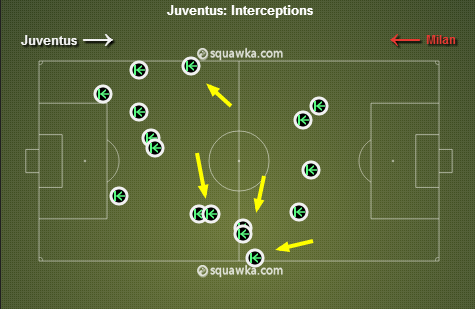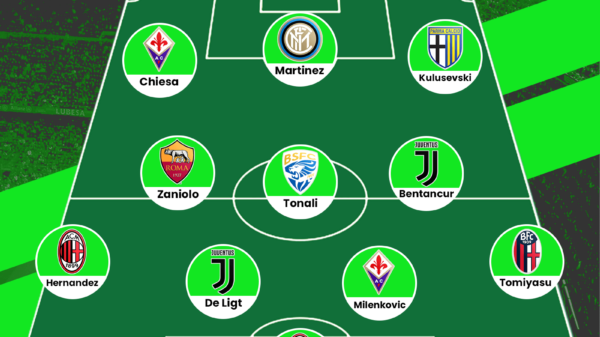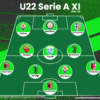As Roma have run away at the top of the table in Serie A, some of the traditional giants like Juventus and Milan have had slightly lukewarm starts to their season. So, there was a lot at stake for both managers in the clash between these two teams, as victory in a match against a big rival can kick start the season. Milan were the visitors to Turin on this occasion.
The home side started with a 3-5-2 formation. Buffon and the usual trio of Bonucci, Barzagli and Chiellini started at the back. In midfield too, the familiar trio of Pirlo, Marchisio and and Vidal started. The wings were manned by Asamoah on the left, and Padoin on the right. Up front, Quagliarella played as the one who tried to run in behind, while Tevez dropped deeper to link play.
AC Milan began the game in a 4-1-3-2 formation that their manager Allegri favours. The 4 at the back were Abate, Zapata, Mexes and Constant. De Jong sat in front of them, and Montolivo, Nocerino and Muntari played as the narrow midfielders. Robinho was tasked with playing a little deeper to link play and exploit the space that was created by Matri running in behind.

Made with our very own Tactics Creator App. Click here to make your own!
Juve Defending Versus Milan Forwards
Milan started with a pretty decent front two of Matri and Robinho. The objective was to have Matri running in behind to create space for the Brazilian forward. Generally, this tactic is useful to force Juve back, because Pirlo isn’t as effective in defence as he is as an attacker. Therefore, Juventus had Leonardo Bonucci kept moving a little bit higher to mark Robinho and cut out the space that may have been created for him in this way.
The other Juventus defenders did well to track the runs that Matri made in behind Bonucci, and this meant that the Milan forwards were rendered quite ineffective.
No Pressing
Going into this game, Milan would have been very happy if they were given a point at the end of it. Therefore, they set up to play through counter attacks. The defence and the midfield sat quite deep and allowed the Juve players space in their own half. Often, Juventus even managed to make it to the edge of the Milan area very easily, especially in the first 20 minutes, when they were searching for the equaliser.
Football Blogging Awards: Click here and vote for us in the “Best New Football Blog” Category
Juventus too, weren’t really pressing the ball in the first half, allowing the Milan players to have in the deeper regions. The only reason they managed to win the ball a few times was the amount of individual errors and passing mistakes the Milan team made when passing out from the back. Mexes was one of the guilty parties. Of course, it was easy for Juventus to stay around the half way line, because Milan had just 3 bodies back when on the ball. The full backs had to move forward to provide width, while only De Jong stayed close to the centre backs while they had the ball. Riccardo Montolivo had to go further forward to find space to operate in, as he couldn’t afford to be too close to De Jong, so he couldn’t help out with balls from deep either.
Another reason for the ineffective pressing from Juventus was Carlos Tevez. The Argentine is a player who always harries defenders, but he was played in a slightly deeper role by Conte today to effect quick counter attacking transitions. This meant that Quagliarella was left to play in the region where Milan had a lot of the ball, and he isn’t as intense off the ball as Tevez.

A lot of the Juve interceptions happened when Milan failed to play the ball out from the back correctly.
via squawka.com
Crowded Midfield
The game was quite scrappy, and this was due in no small part to the crowded midfield. Milan had 4 players in a central area, and Juventus had 3. Add to that the fact that Bonucci was pushing forward occasionally to mark Robinho. Milan wanted it to play out this way as it would choke the Juventus play, who like to spread it wide to stretch the game. They showed the Juve wingbacks inside almost all the time, to keep the play narrow. 42% of the Juventus attacks ended up coming through the middle. This was why the teams struggled to make any meaningful play from the middle.
Another thing it resulted in was a great involvement from the defenders in the attacking parts of the game. The Juventus back 3 had 176 touches during the game, and the Milan back 4 a massive 320. Going forward as well, they were quite important, with Constant picking up an assist, and Chiellini scoring, aside from a few long range efforts. The fact that defenders had to attack may also explain the lack of coherent attacking play.
Milan Switches
With the midfield very crowded in the middle, Milan needed to find an alternative avenue of attack. The wing backs, as we know well, are very capable of doing so. Both Abate and Constant are well suited to going forward. Therefore, Milan tried a tactic to get their wing-backs into space, and attacking. The whole of the started moving onto one side, and a few short passes were played in this region of the field. The purpose was to attract the Juventus midfield to the ball, and create space on the opposite wing for the full back to move into. Once this movement was achieved, one of the midfielders, generally Riccardo Montolivo, sprayed a long cross-field pass to release the full back, whose job was then to cross deep for the players who had gathered on the other side of the pitch. Only 28% of their attacks went through the middle, and this, along with long balls over the top, was their solution to counter the midfield crowd.

Long cross field passes by Riccardo Montolivo
via squawka.com
Pogba’s Wing Play
With the crowd in the centre, Conte decided that he had to do something about the wings, which were quite inactive for Juventus. So, around the 50th minute, the ineffective Padoin was withdrawn, and Paul Pogba came on to play on the wing. The other subtle change that Conte made on the right side was to bring Vidal a little bit wider. The idea was to isolate Constant by giving him a player going just inside him, and outside him. It created space for Pogba, and the Frenchman managed to dominate the right wing. This caused Milan a few problems, though it didn’t result in a goal. This also cut off a lot of the attacking threat that Milan had been posing from the wings, as Pogba and Vidal kept Constant busy enough for him to hang back most of the time.
Conclusion
In a game that was strewn with individual errors across the park, Juventus did well to take 3 points in a 3-2 victory. Milan worked hard, but their negative tactics, and lack of effective attacking options were exposed by the quality that a very fit and strong Juventus side eventually showed.
Over to you! That was our analysis of the derby, was there anything particular that you (tactically) noticed? Let us know by dropping a comment below.
Make sure you follow us on Twitter @OOTB_football and like us on Facebook. We’re on Google+ and Tumblr as well for those interested.
CLICK HERE TO READ OUR OTHER TACTICAL ANALYSES
- Analysis: Are Chelsea’s pressing issues a concern? - October 5, 2020
- Has Financial Fair Play Been Worth It? - August 27, 2020
- Tactical Philosophy: Frank Lampard - May 20, 2020


























































